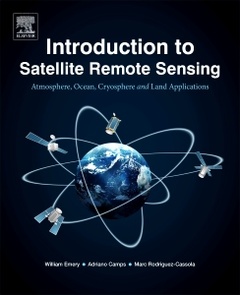Description
Introduction to Satellite Remote Sensing
Atmosphere, Ocean, Land and Cryosphere Applications
Authors: Emery William, Camps Adriano
Language: English
Subjects for Introduction to Satellite Remote Sensing:
Keywords
Aerial photography; Aerosol; Albedo; Altimeters and scatterometers; Altimetric signal; Astro Digital; AVHRR; Basebanding; Chlorophyll; Cloud absorption radiometer; Cloud shapes; Cloud types; Coarse acquisition; CryoSat; Cryosphere; Delay-Doppler map; Demodulation; Dicke radiometer; Doppler analysis; Electromagnetic waves; Field of view; Filter-wheel radiometer; Gain pattern; Geometric corrections; Georectification; GOES program; Hayman fire; Highly elliptical orbits; Hyperspectral imagers; ICESat; Image navigation; Infrared imagers; Infrared; Landsat; LIDAR; Map projections; Mapping; Mass spectrometer; Mesoscale; Microwave radars; MIRAS; NDVI; NOAA; Polar regions; Polarization; QuikSCAT; Radar; Radio occultation; Radio-astronomy; Radiometer calibration; Radiometer; Rayleigh scattering; Remote sensing; Scatterometer; Scatterometry; Sea ice drift; SMOS; Spectrometers; SPOT satellites; Swath width; Synthetic aperture radar; Thermal infrared; TIROS; TOVS data; Transmissivity; Vegetation optical depth; Vignetting
860 p. · 19x23.3 cm · Paperback
Description
/li>Contents
/li>Biography
/li>Comment
/li>
Introduction to Satellite Remote Sensing: Atmosphere, Ocean and Land Applications is the first reference book to cover ocean applications, atmospheric applications, and land applications of remote sensing.
Applications of remote sensing data are finding increasing application in fields as diverse as wildlife ecology and coastal recreation management. The technology engages electromagnetic sensors to measure and monitor changes in the earth?s surface and atmosphere.
The book opens with an introduction to the history of remote sensing, starting from when the phrase was first coined. It goes on to discuss the basic concepts of the various systems, including atmospheric and ocean, then closes with a detailed section on land applications.
Due to the cross disciplinary nature of the authors? experience and the content covered, this is a must have reference book for all practitioners and students requiring an introduction to the field of remote sensing.
1. The History of Satellite Remote Sensing2. Basic Electromagnetic Concepts and Applications to Optical Sensors3. Optical Imaging Systems4. Microwave Radiometry5. Radar6. Remote Sensing Using Global Navigation Satellite System Signals of Opportunity7. Orbital Mechanics, Image Navigation, and Cartographic Projections8. Atmospheric Applications9. Oceanic Applications10. Terrestrial Applications11. Cryospheric Applications12. Remote Sensing With Small Satellites
Adriano Camps received his Ph D in Telecommunications Enginering from the Universitat Politècnica de Catalunya in 1992. He is an IEEE Fellow and Full Professor at the Universitat Politècnica de Catalunya-Barcelona Tech, where he teaches Remote Sensing courses, other disciplines relates to Electromagnetism, and a course on Small Satellites. His research interests are microwave radiometry, with special emphasis in synthetic aperture radiometers, and GNSS-R. He is now developing nanosatellites to tests innovative remote sensors, and in particular a GNSS-R payload. He has published over 145 journals papers, and 325 conference papers. He has advised 20 Ph D Theses (+5 on going).
- Provides study questions at the end of each chapter to aid learning
- Covers all satellite remote sensing technologies, allowing readers to use the text as instructional material
- Includes the most recent technologies and their applications, allowing the reader to stay up-to-date
- Delves into laser sensing (LIDAR) and commercial satellites (DigitalGlobe)
- Presents examples of specific satellite missions, including those in which new technology has been introduced




